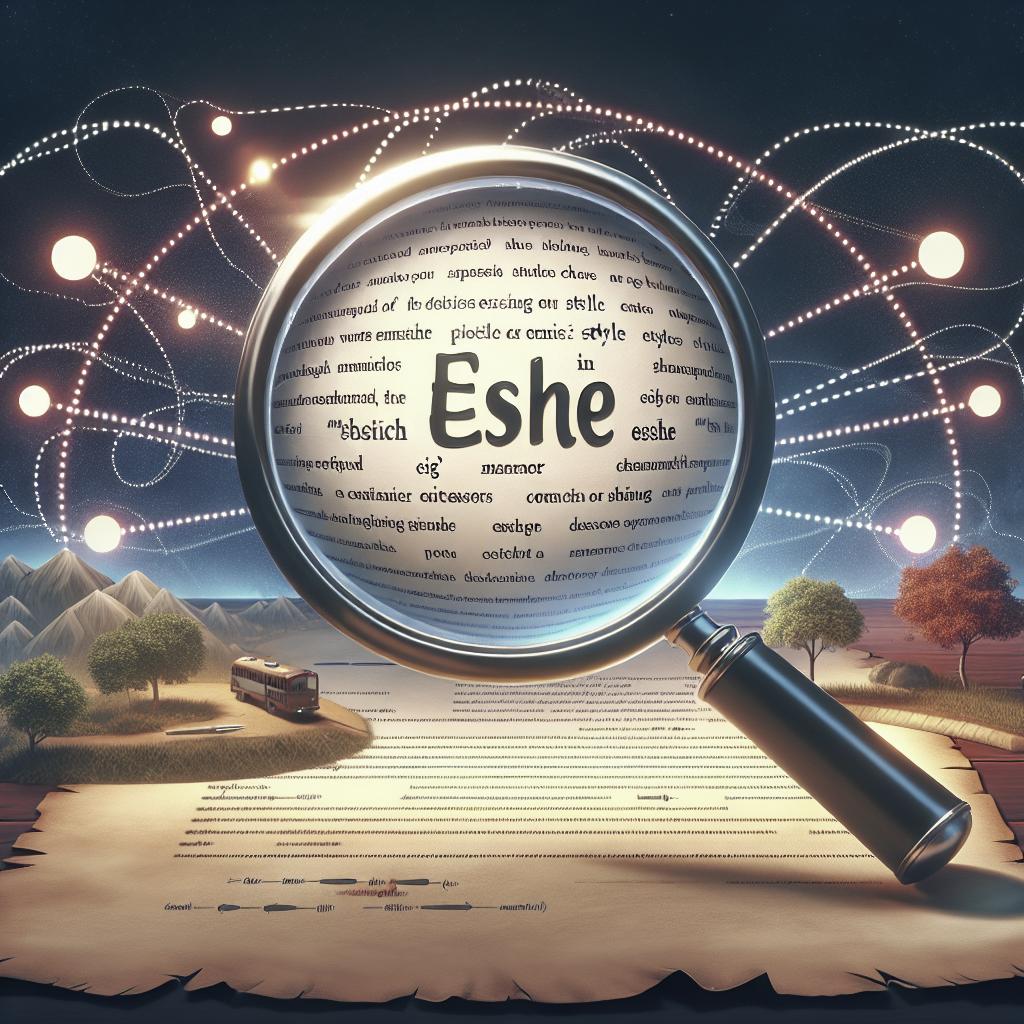In the colorful world of language, suffixes provide enriching nuances to our everyday vocabulary. Among these suffixes, the elegant and artistic “-esque” offers a unique flair to expression. This blog post embarks on a journey, delving into the fascinating origins and significance of “-esque,” a suffix often used to craft words that convey likeness or resemblance to something recognizable. We’ll explore its etymology, delve into its rich meaning, and provide comprehensive guidance on how to effectively incorporate this suffix into your writing. Additionally, we’ll compare it to similar suffixes like “-ish” and “-like,” and illustrate its versatility through various “-esque” words suitable for different contexts. To tie it all together, we’ll demonstrate how to use “-esque” effectively in everyday sentences while addressing grammar-related nuances. Whether you’re a language enthusiast or a burgeoning writer, this entry will equip you with the knowledge to use “-esque” with elegance. ### Etymology of the “-esque” Suffix The suffix “-esque” finds its roots in the rich tapestry of Romance languages, originating from the Italian suffix “-esco” and the French “-esque.” These, in turn, stem from the Latin “-iscus,” which signifies belonging to or resemblance of. Historically, the suffix has been used to attach a distinct or stylistic essence of one thing to another, often transcending the literal to invoke an evocative image or idea. In the English language, “-esque” emerged around the early 18th century. It was adopted to bestow a continental and sophisticated flavor to English words, often used in literary and artistic contexts. As English evolved, this suffix maintained its stature as a useful tool for writers seeking to draw vivid comparisons or stylistic resemblances, offering readers an immediate visual or conceptual cue. ### Meaning of -esque as a Suffix The suffix “-esque” serves to transform a noun into an adjective, indicating a likeness to the noun it’s attached to. This transforms the base word into something that conveys similarity, style, or a reminder of the original. For instance, when one speaks of a “Kafkaesque” scenario, they are describing something reminiscent of Franz Kafka’s uniquely surreal and oppressive style. While the use can be subtle, the strength of “-esque” lies in its ability to conjure deep, often complex associations within a succinct term. It moves beyond basic similarity, tapping into the essence or defining features of the original subject. The derived words are often evocative and culturally rich, allowing for expressive storytelling and nuanced communication. ### How to Use the “-esque” Suffix To effectively use the “-esque” suffix, it’s important to grasp the character and essence of the root word you intend to modify. The key is understanding what specific qualities or stylistic elements you want to convey. When you say something is “Gothic-esque,” for example, ensure you are well-versed in what defines Gothic characteristics—be it in architecture, fashion, or literature. Incorporating “-esque” successfully also involves maintaining clarity in communication. Use it to sharpen your narrative or describe complex feelings without overcomplicating your language. It’s equally critical to ensure that the audience understands the reference. Opting for culturally or commonly known subjects, especially in broader or non-specialized writing, prevents misinterpretation and enhances comprehension. ### Can You Add “-esque” to Any Word? While the flexibility of “-esque” invites creative variations, not every word seamlessly transforms with this suffix. Care must be taken to ensure that the resulting term is meaningful and contextually appropriate. Attaching “-esque” to well-recognized figures, styles, or concepts often works best due to their established cultural resonance. It’s advisable to avoid forcing “-esque” onto obscure or overly complex terms where the intended reference isn’t widely understood. For instance, “chair-esque” might not carry significant meaning unless you are discussing specific chair designs or styles. When creatively coining new “-esque” words, consider your audience and aim for terms that enhance, rather than obscure, understanding. ### Different “-esque” Words to Consider Many established “-esque” words have found their place in the English lexicon, each carrying its unique connotations. “Kafkaesque,” as mentioned earlier, brings to mind surreal and illogical narratives, often suggesting a nightmarish complexity. “Monet-esque” suggests a blurred, impressionistic quality reminiscent of the works of Claude Monet, often used to describe artistic style rather than explicit depiction. Other examples include “grotesque,” which not only captures physical deformity but also an absurd or outlandish vibe, and “picturesque,” suggesting a visually attractive quality. When exploring “-esque” words, focus on those that resonate with the imagery or tone you wish to convey, enriching your language and providing vibrant descriptors for familiar themes. ### Esque vs. -ish vs. -like While “-esque” encapsulates style and depth, the suffixes “-ish” and “-like” offer more straightforward but less nuanced likenesses. “-Ish” often implies a degree of approximation or partial resemblance. For instance, “childish” denotes behaviors akin to a child, but with a potential pejorative undertone, highlighting immaturities. On the other hand, “-like” provides a straightforward comparison, usually without the stylistic flair of “-esque.” Using “child-like,” the similarity emphasizes innocence or simplicity. “-Esque” raises the bar by infusing nuance and sometimes broader cultural connotations, making it especially useful in thematic or creative contexts that benefit from layered meanings. ### Using “-esque” in a Sentence When it comes to sentence construction, placing an “-esque” word requires consideration of flow and clarity. For instance, “The filmmaker’s latest work is a Lynchian masterpiece—eerily reminiscent of a bizarre, dream-like state,” uses “Lynchian” to evoke director David Lynch’s hallmark style immediately. Another example might be: “The novel is Tolkien-esque, weaving an intricate tapestry of mythical creatures and ancient lore.” Such usage invites readers to envision and anticipate familiar elements, tapping into their pre-existing cultural knowledge for richer engagement. Practice these structures to enhance writing that demands descriptive precision and emotional resonance. ### Grammar-esque In terms of grammar, the addition of suffixes like “-esque” doesn’t complicate sentence structure considerably. However, maintaining grammatical consistency is essential to preserve clarity. “-Esque” words, functioning as adjectives, must appropriately modify the nouns they describe. Two key areas to watch out for include agreement in number and ensuring that the modified noun’s placement makes sense contextually. For instance, “Her stance was almost statue-esque, radiating calm and poise,” an anomaly occurs if the placement of the adjective is incorrect, potentially leading to misunderstandings. Being aware of such nuances allows for more sophisticated and error-free application. ### Future Prospects Below is a summary in tabular form to encapsulate the key points of understanding and using the “-esque” suffix. This guide distills the essence into a visual resource that enhances both comprehension and application in diverse writing contexts. “`html
| Section | Key Points |
|---|---|
| Etymology of the “-esque” Suffix | Originates from Italian and French; indicates resemblance. |
| Meaning of -esque as a Suffix | Transforms nouns into adjectives to convey likeness. |
| How to Use the “-esque” Suffix | Ensure cultural resonance and maintain clarity in communication. |
| Can You Add “-esque” to Any Word? | Avoid obscure terms; focus on established, culturally known figures or styles. |
| Different “-esque” Words to Consider | Examples include Kafkaesque, Monet-esque, picturesque, grotesque. |
| Esque vs. -ish vs. -like | “-esque” offers stylized likeness whereas “-ish” and “-like” are more straightforward. |
| Using “-esque” in a Sentence | Integrate into sentences to enhance descriptive clarity and resonance. |
| Grammar-esque | Maintain grammatical consistency; ensure adjectives correctly modify nouns. |
“`


